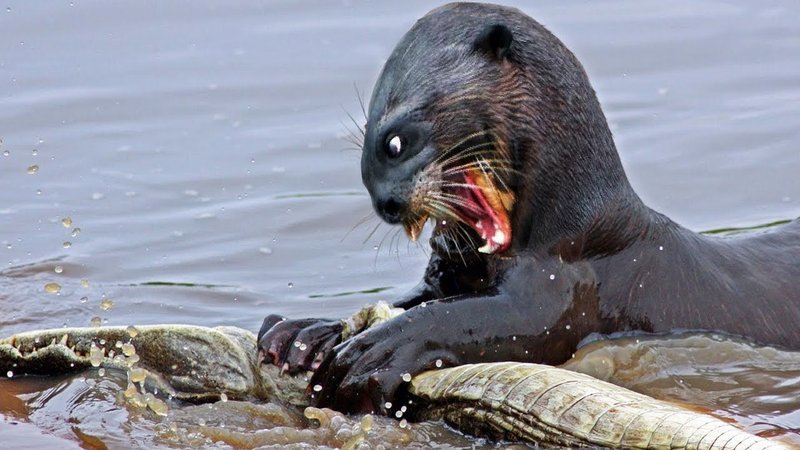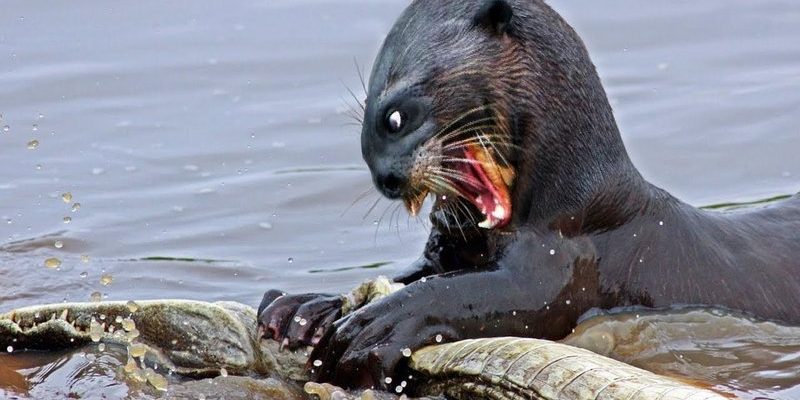
On one hand, giant otters are known for their social behavior and family units, often hunting and playing together in groups. On the other hand, they can be quite fierce when it comes to protecting their territory or young. So, how dangerous can they really be? Let’s dive into the world of the giant otter and explore this intriguing question.
What Are Giant Otters?
Let’s start with a little background. Giant otters are the largest members of the weasel family, reaching up to six feet long and weighing around 70 pounds. Unlike your average pet otter, these guys are built for life in the wild, with webbed feet, water-repellent fur, and sharp teeth. They thrive in freshwater habitats, such as rivers, lakes, and wetlands, primarily found in countries like Brazil, Peru, Colombia, and Venezuela.
These otters are social creatures that often live in family groups of 3 to 20 individuals. They communicate using a variety of vocalizations, which can range from chirps to growls. Honestly, observing their interactions is like watching a well-rehearsed play—full of drama, teamwork, and the occasional spat over food. Their diet mainly consists of fish, crustaceans, and small mammals, making them adept hunters.
However, despite their playful appearances, these creatures have a wild side that comes out when threatened. Let me explain how their behavior might play into their interaction with humans.
Understanding Their Behavior
Giant otters are known for their strong bonds within their families. They work together to hunt and protect each other. But here’s the thing: when they feel threatened, their fierce protective instincts kick in. They’re not afraid to defend their territory or young with surprising aggression.
When it comes to human encounters, giant otters might react in one of two ways. In some cases, they may ignore people or even curiously approach, especially if they’re used to human presence. But if they feel cornered or believe their family is at risk, they can become aggressive. Think of it like a parent bear; you wouldn’t want to get too close to a momma bear with cubs!
This behavior establishes that while giant otters can indeed be friendly and playful, they are also capable of violence if provoked. So, it’s always wise to respect their space.
Encounters with Humans: Stories and Incidents
There have been various reports of encounters between giant otters and humans, and they can range from delightful to alarming. For instance, there are stories from fishermen who have had giant otters swim up to their boats, floating curiously before darting away. These encounters can create magical moments, reminding us of nature’s wonders!
However, there are also accounts of swimmers or kayakers having close calls. In some regions, giant otters are known to protect their territories aggressively. In one tale, a group of tourists kayaking in Brazil found themselves surrounded by a family of giant otters. Instead of retreating peacefully, the otters began to display aggressive posturing, making loud calls and even splashing water. It served as a reminder that while they might seem friendly, they have a fierce side when their home is threatened.
These stories highlight the importance of understanding how these animals interact with their environment and, ultimately, with humans. As with many wildlife encounters, respecting their habitat and keeping a safe distance is key.
Myths and Misconceptions
When it comes to giant otters, there are a few myths floating around that deserve clarification. One common misconception is that they are just cuddly, harmless creatures. Yes, they look adorable, but they have sharp teeth and powerful jaws, which they use for catching prey and defending themselves.
Another misunderstanding is that they are universally aggressive towards humans. While they can be protective, not every encounter will result in aggression. In fact, many people—especially locals who live near their habitats—often have positive interactions. The difference in these encounters usually comes down to whether the otters feel threatened or not.
So, if you find yourself near a giant otter habitat, don’t assume they’ll immediately be aggressive. Just approach with respect and caution, and you might be rewarded with a different view of these fascinating animals.
How to Stay Safe Around Giant Otters
If you ever plan on visiting areas where giant otters are present, it’s essential to know how to keep yourself safe. Here are some recommended tips:
- Observe from a distance: Use binoculars or a camera with a zoom lens for viewing.
- Avoid approaching their dens or young: Like all wildlife, they can become aggressive if they feel their young are threatened.
- Stay calm: If you encounter them and they seem agitated, slowly back away without sudden movements.
- Educate yourself: Knowing their behavior can help you react appropriately in an encounter.
By following these simple guidelines, you can enjoy the beauty of the giant otter while minimizing the chance of an aggressive encounter.
So, can the giant otter be dangerous to humans? The answer isn’t a simple yes or no. While they’re primarily playful and social animals, their protective nature can lead to aggressive behavior if they feel threatened. Understanding their behavior, respecting their habitat, and being cautious during encounters is crucial.
These incredible creatures remind us that wildlife, while often fascinating and charming, also has its wild side. By learning about their habits and respecting their boundaries, we can coexist peacefully with these amazing animals. Next time you’re in their territory, you might just find yourself captivated by their antics—just remember to keep a safe distance!

